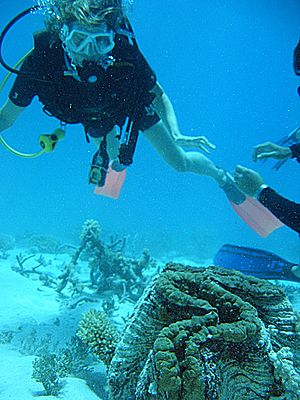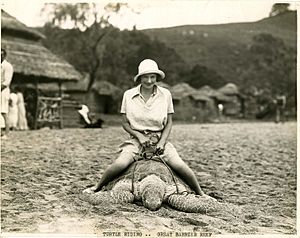Tourism on the Great Barrier Reef facts for kids
The Great Barrier Reef is a huge natural wonder. Many people visit it every year. Tourism is a very important industry for the area. It brings in a lot of money for Australia. It also provides many jobs for people. Experts say the Great Barrier Reef is special. It is known as the "most untouched coral reef on Earth." The people who manage the reef work hard to keep it safe. They make sure that visitors have a very small impact on the reef. They do this by giving out permits for camping and all business tours.
Contents
Great Barrier Reef Tourism History
Early Adventures on the Reef
The first known visits for fun happened in the 1890s. This was on Green Island. In the early 1900s, scientists started exploring the reef. Their trips helped set the stage for tourism. People also used to visit Aboriginal missions. But this stopped because missionaries did not like tourists giving money to Aboriginal people. Torres Strait Islanders moved south to the Whitsundays. They showed tourists how they hunted turtles. They also performed songs and dances. In 1931, a newspaper called for more tourism. It talked about the great fish that could be caught there. Tourism mostly stopped during World War II.
Growing Popularity of Reef Trips
In the 1960s and 1970s, more and more tourists came. Travel became easier. Boats were made that could go farther out. This allowed day trips of up to 20 nautical miles. Some parts of the Great Barrier Reef were hard to reach. This naturally protected them from too many people.
In 1981, the Great Barrier Reef became a World Heritage site. This means it is very important globally. Australia has a duty to show off the reef. Tourism helps Australia do this. In the 1980s, tourism grew very fast. At one point, there was even a floating hotel! By 1987, about 450,000 tourists visited. More people came because it was easier to fly to places like Cairns International Airport. Also, large catamaran boats allowed longer day trips. These boats could go up to 50 nautical miles. During the 1980s, some people worried that tourism was hurting the reef.
Modern Challenges for Reef Tourism
Tourism numbers went down a little in 2006. This was because of other big events happening overseas. A worldwide money problem in 2008 also caused fewer people to travel. After some big floods in Queensland, many people canceled their trips. This meant a loss of millions of dollars.
In 2012, experts said tourism was changing. This was partly because the Australian dollar was strong. By 2012, tourism in the Great Barrier Reef area was worth about $5.5 billion. After a big storm called Cyclone Marcia, a campaign asked people to visit. This was to help the area recover. In 2016, many corals on the reef became bleached. This means they turned white and were unhealthy. Only 7% of the reef was not affected. The tourism industry started a special online tag, #GBRtoday. They used it to show pictures of healthy corals. Also in 2016, the Australian government asked for a part about climate change to be removed. This was from a report about the reef by UNESCO. They worried it might stop tourists from coming. After this, fewer Australians visited the reef.
Where Do Tourists Go?
Most tourism in the Great Barrier Reef area happens in two main spots. These are the Cairns area and the Whitsunday area. About 85% of all visitors go to these places.
Boats and Trips
Many tours use boats. These boats can carry from 10 to over 400 people. Some boat trips can last for weeks. They move between different parts of the reef.
Who Visits the Reef?
A study in 2003 looked at visitors to the Whitsundays. It found that many were visiting the Great Barrier Reef for the first time. Their average age was 37. Most were from other countries. They often visited with a partner or their family. They usually went snorkelling, swimming, or took a tour in a semi-submersible boat. These boats let you see underwater without getting wet.
Visitors expect to see beautiful islands and beaches. They want to experience a "natural, untouched environment." They also hope to see many different fish and corals. They compare what they see to the amazing pictures in travel ads.
Another study found that older tourists did fewer activities. They might not be the best group to focus on for many activities.
Some people visit the Great Barrier Reef more than once. These repeat visitors are often younger. Many are backpackers or tourists from other parts of Australia. If they are from other countries, they often come from North America or Europe. They are more likely to go scuba diving. They also tend to look for smaller, special tours for their return visit.
A survey in 2015 found something interesting. Two-thirds of tourists wanted to see the Great Barrier Reef before it changed too much.
Protecting the Reef
Rules and Fees
The Great Barrier Reef Marine Park Act 1975 is a main law. It helps manage the Great Barrier Reef Marine Park. When this law was made, managing tourism was a big concern.
In 1991, a politician named Ros Kelly suggested a small tax. It was a 1% tax on tourism activities in the reef. But the leader of Queensland, Wayne Goss, did not like this idea.
Now, all businesses that run tours in the Marine Park must pay a fee. It is called the Environmental Management Charge (EMC). This fee started in 1993. It helps pay for the Great Barrier Reef Marine Park Authority. This group manages the reef. In 2009–2010, the fee provided 18% of their money.
Images for kids
-
Snorkelling on the Great Barrier Reef, 2011
-
Gold Coast, Queensland, a popular holiday spot in Australia. It is known for its beaches, relaxed lifestyle, tall buildings, and being close to four big amusement parks.






